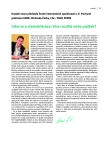New SGLT2 inhibitor empagliflozin: modern and safe treatment of diabetes
Authors:
Zdeněk Rušavý
Authors‘ workplace:
Diabetologické centrum I. interní kliniky LF UK a FN Plzeň, přednosta prof. MUDr. Martin Matějovič, Ph. D.
Published in:
Vnitř Lék 2014; 60(11): 926-930
Category:
Reviews
Overview
Empagliflozin is agent of new antidiabetic drugs that cause glycosuria blocking the glucose reuptake in the proximal tubule. The loss of 50-100 g of glucose / 24 hours in the urine results in a reduction of fasting glucose, especially post-prandial glucose, the energy expenditure of 200-400 kcal / day and blood pressure lowering. Treatment efficacy does not decrease over time, as it is not dependent on its own insulin production. The work evaluates the safety of modern treatment with empagliflozin which will soon appear in the portfolio of antidiabetic agents in the Czech Republic. The conducted studies with a special focus on empagliflozin treatment have shown high efficacy, safety and good tolerability of drug. It has been described a higher incidence of genital infections with non-severe course, especially in women. The drug does not cause hypoglycaemia. In combination with sulfonylurea hypoglycaemia may occur. Empagliflozin does not cause clinically significant dehydration or hypotension in patients about 60 years of age, but some caution in empagliflozin treatment should be in elderly and fragile patients. The big convenience of empagliflozin is its clinically non-significant interactions with other drugs and simple dosage of 1 tablet / day orally. In conclusion, empagliflozin is highly effective oral antidiabetic agent with a potential of wide application in all stages of type 2 diabetes in monotherapy or combined with other medication. The treatment is associated with weight loss and blood pressure lowering. The drug is effective and safe until eGFR 45 ml / s, in lower values the treatment should be discontinued. The occurrence of side effects is rare, except increased incidence of genital infections especially in women and increased risk of hypoglycaemia when empagliflozin is combined with sulfonylurea.
Key words:
diabetes mellitus type 2 – diabetes treatment – empagliflozin – HbA1c – SGLT2
Sources
1. Hummel CS, Lu C, Loo DD et al. Glucose transport by human renal Na+/D-glucose cotransporters SGLT1 SGLT2. Am J Physiol 2011; 300(1): C14-C21.
2. McGill JB. The SGLT2 Inhibitor Empagliflozin for the Treatment of Type 2 Diabetes Mellitus: a Bench to Bedside Review. Diabetes Ther 2014; 5(1): 43–63.
3. Ferrannini E, Muscelli E, Frascerra S et al. Metabolic response to sodium - glucose contransporter 2 inhibition in type 2 diabetic patients. J Clin Invest 2014; 124(2): 499–508.
4. Ferrannini E, Hach T, Crowe S et al. Energy balance following sodium-glucose co-transporter-2 (SGLT2) inhibition. Diabetes 2014; 63(Suppl 1A): LB32.
5. Roden M, Weng J, Elbracht J et al. Empagliflozin monotherapy with sitagliptin as a active comparator in patients with type 2 diabetes: a randomised, double-blind placebo-controlled phase 3 trial. Lancet Diabetes Endocrinol 2013; 1(3): 208–219.
6. Häring HU, Merker L, Seewaldt-Becker E et al. Empagliflozin as add-on to metformin in patients with type 2 diabetes: a 24-week, randomized, double-blind, placebo-controlled trial. Diabetes Care 2014; 37(6): 1650–1659.
7. Häring HU, Merker L, Seewaldt-Becker E et al. Empagliflozin as add-on to metformin plus sulfonylurea in patients with type 2 diabetes: a 24-week, randomized, double-blind, placebo-controlled trial. Diabetes Care 2013; 36(11): 3396–3404.
8. Kovacs CS, Seshias V, Swallow et al. Empagliflozin improves glycemic and weight control as add-on therapy to pioglitazone plus metformin in patients with type 2 diabetes: a 24-week randomized, placebo-controlled trial. Diabetes Obes Metab 2014; 16(2): 147–158.
9. Merker L, Häring HU et al. Empagliflozin (EMPA) for ≥76 weeks as add-on to metformin in patients with type 2 diabetes (T2DM). Diabetes 2014; 63(Suppl 1): A278. 1074-P.
10. Häring HU, Merker L et al. Empagliflozin (EMPA) for ≥76 Weeks as Add-on to Metformin Plus Sulfonylurea (SU) in Patients with Type 2 Diabetes (T2DM). Diabetes 2014; 63(Suppl 1): A280. 1077-P.
11. Kovacs CS, Veeraswamy S et al. Empaglifl ozin (EMPA) for ≥76 Weeks as Add-on to Pioglitazone With or Without Metformin in Patients with Type 2 Diabetes (T2DM). Diabetes 2014; 63(Suppl 1): A273. 1055-P.
12. Rosenstock J, Jelaska A, Wang F et al. EMPA-REG BASAL Trial Investigators. Empagliflozin as add-on to basal insulin for 78 weeks improves glycemic control with weight loss in insulin-treated type 2 diabetes (T2DM) (Abstract). Diabetes 2013; 62(Suppl 1): A285.
Labels
Diabetology Endocrinology Internal medicineArticle was published in
Internal Medicine

2014 Issue 11
Most read in this issue
- New aspects of hormone replacement therapy
- LDL-apheresis in the treatment familial hypercholesterolemia
- New SGLT2 inhibitor empagliflozin: modern and safe treatment of diabetes
- Extended options of anticoagulant treatment in thromboembolism
